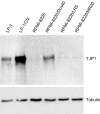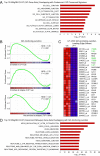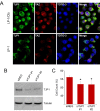Increased expression of the tight junction protein TJP1/ZO-1 is associated with upregulation of TAZ-TEAD activity and an adult tissue stem cell signature in carfilzomib-resistant multiple myeloma cells and high-risk multiple myeloma patients
- PMID: 28966941
- PMCID: PMC5616201
- DOI: 10.18632/oncoscience.356
Increased expression of the tight junction protein TJP1/ZO-1 is associated with upregulation of TAZ-TEAD activity and an adult tissue stem cell signature in carfilzomib-resistant multiple myeloma cells and high-risk multiple myeloma patients
Abstract
Tight junction protein 1 (TJP1) has recently been proposed as a biomarker to identify multiple myeloma (MM) patients most likely to respond to bortezomib- and carfilzomib-based proteasome inhibitor regimens. Herein we report increased expression of TJP1 during the adaptive response mediating carfilzomib resistance in the LP-1/Cfz MM cell line. Moreover, increased TJP1 expression delineated a subset of relapsed/refractory MM patients on bortezomib-based therapy sharing an LP-1/Cfz-like phenotype characterized by activation of interacting transcriptional effectors of the Hippo signaling cascade (TAZ and TEAD1) and an adult tissue stem cell signature. siRNA-mediated knockdown of TJP1 or TAZ/TEAD1 partially sensitized LP-1/Cfz cells to carfilzomib. Connectivity Map analysis identified translation inhibitors as candidate therapeutic agents targeting this molecular phenotype. We confirmed this prediction by showing that homoharringtonine (omacetaxine mepesuccinate) - the first translation inhibitor to be approved by the U.S. Food and Drug Administration - displayed potent cytotoxic activity on LP-1/Cfz cells. Homoharringtonine treatment reduced the levels of TAZ and TEAD1 as well as the MM-protective proteins Nrf2 and MCL1. Thus, our data suggest the importance of further studies evaluating translation inhibitors in relapsed/refractory MM. On the other hand, use of TJP1 as a MM biomarker for proteasome inhibitor sensitivity requires careful consideration.
Keywords: Nrf2; TJP1/ZO-1; WWTR1/TAZ-TEAD1; cancer stem cell-related features; carfilzomib; homoharringtonine; multiple myeloma; proteasome inhibitors; translation inhibitors.
Conflict of interest statement
CONFLICTS OF INTEREST The authors declare no conflict of interest.
Figures








References
-
- Kumar SK, Lee JH, Lahuerta JJ, Morgan G, Richardson PG, Crowley J, Haessler J, Feather J, Hoering A, Moreau P, LeLeu X, Hulin C, Klein SK, et al. Risk of progression and survival in multiple myeloma relapsing after therapy with IMiDs and bortezomib: a multicenter international myeloma working group study. Leukemia. 2012;26:149–157. - PMC - PubMed
-
- Siegel DS, Martin T, Wang M, Vij R, Jakubowiak AJ, Lonial S, Trudel S, Kukreti V, Bahlis N, Alsina M, Chanan-Khan A, Buadi F, Reu FJ, et al. A phase 2 study of single-agent carfilzomib (PX-171-003-A1) in patients with relapsed and refractory multiple myeloma. Blood. 2012;120:2817–2825. - PMC - PubMed
-
- Abraham J, Salama NN, Azab AK. The role of P-glycoprotein in drug resistance in multiple myeloma. Leuk. Lymphoma. 2015;56:26–33. - PubMed
LinkOut - more resources
Full Text Sources
Other Literature Sources
Research Materials

